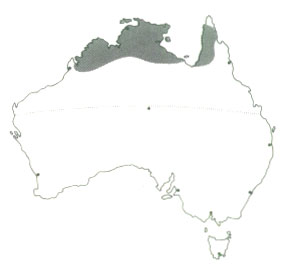![]()
 |
 |
DISTRIBUTION: Moderately common in open woodland and grassland. Two subspecies; Poephila personata leucotis in Cape York Peninsula and Poephila personata personata in rest of range across north and north-west Australia. |
White-eared Masked Finch |
Distribution Map |
|
IDENTIFICATION. LENGTH = 120 mm MALE: Head and back pale brown; rump and upper tail-coverts white; tail black. Forehead, lores, front of face and chin black; breast and throat pink-brown; centre of belly and undertail-coverts white; black patch on lower flank. Eye brown; bill yellow; legs red-orange. In Cape York Peninsula subspecies, white-eared grass finchPoephila personata leucotis, ear-coverts and patches on lower flanks white. FEMALE: Similar to male; black face mask smaller. IMMATURES: As adults but duller; bill black; face mask partly grey.
|
NESTING. Breeds March-June. Nest flask-shaped, 110-160 mm long, 100-130 mm high and 110 mm wide. Bulky and globular chamber with short entrance tunnel. Constructed of dead grass stems and lined with plant fibre, feathers and sometimes fur; pieces of charcoal frequently found in nest chamber. Placed in bushed and trees or grass. Eggs: four to six; pure white; 17 X 12 mm. |
|
FORMS. There are two forms the Long-tailed Finch Poephila personata leucotis and the White-eared Long-tailed Finch Poephila personata personata.
|
|
AVIARY BREEDING. NESTING TYPES: I have found that these birds will nest almost anywhere although they will usually prefer a nest box including parrot nest boxes rather than build a nest of their own. I have seen these birds build nests in tea tree branches and planted trees but very rarely. Best results have been from boxes 150 mm square X 125 mm high with a 40 mm access hole in the front and a small landing platform just below the entrance. (See the Plans page for more information) FEEDING: A general finch mix is ideal for this bird. Birds will also readily take seeding grasses and live food. However I have had seen these birds breed successfully with just a mixed seed diet. Egg and biscuit will also be taken readily. OTHER FEEDS: Cuttlebone and shell grit should be supplied at all times. SPECIAL REQUIREMENTS: There are no special requirements for this species. However care should be taken not to house this species with the Masked Finch or the Long-tailed Finch or any of the subspecies.
|
| AVIARY SPECIFICATIONS. | WIRE MESH: 1/4 x 1/4 or 6 mm x 6 mm | Also known as mouse wire |
| LENGTH: 11ft 6in or 3575 mm | WIDTH:6ft or 1800 mm | HEIGHT: 8ft or 2400 mm |
| SHED: Half the aviary should be enclosed.
These are recommendations only and individual breeders may have different dimensions and specifications.
|
FLOOR: I have found a dirt floor preferable. |
OTHER: |
|
BREEDER SUBMISSIONS. |
|
| From |
![]()
Author
P Campbell
Copyright © 2002 P. Campbell. All rights reserved.
Revised: April 21, 2002
.